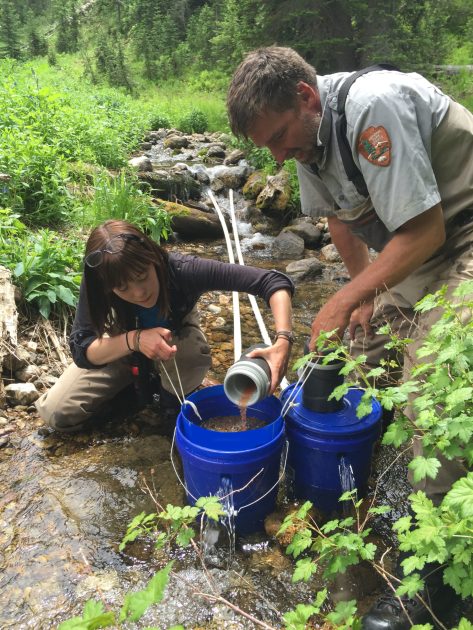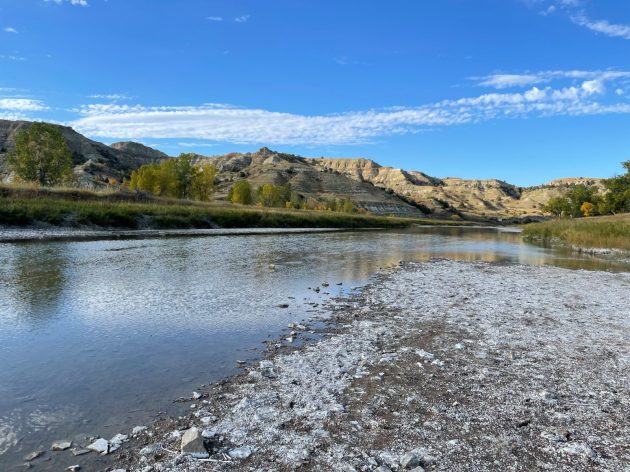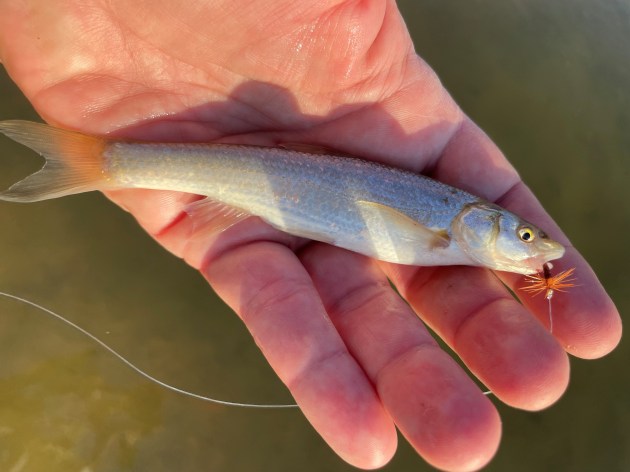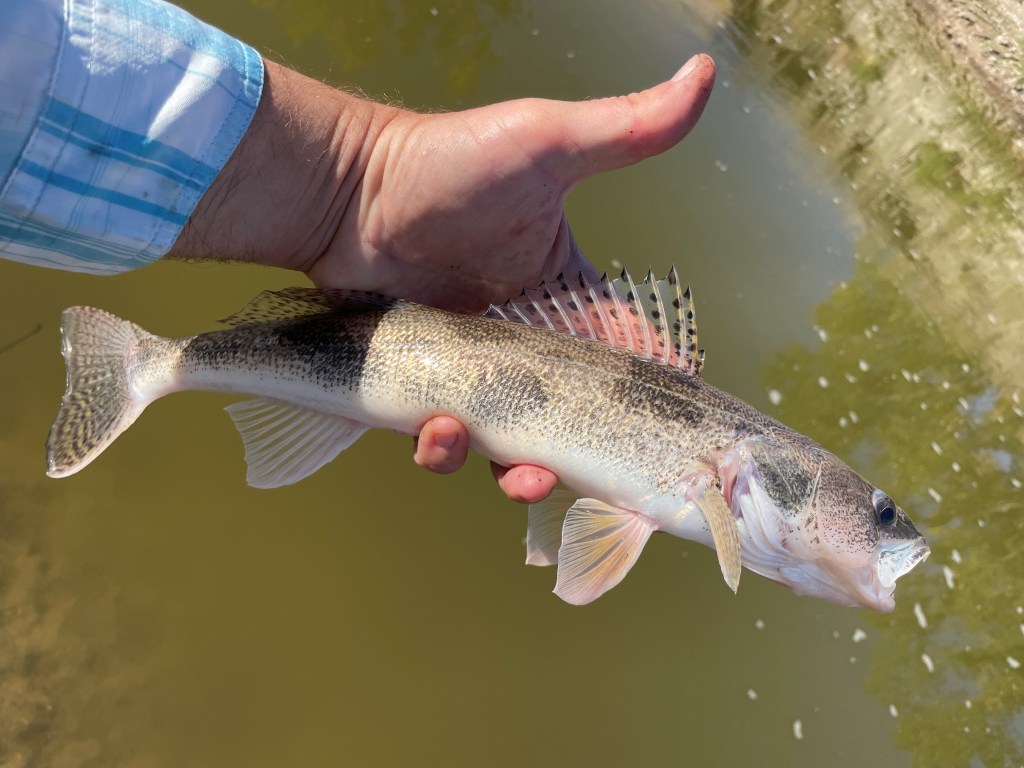I’m on a quest to catch a fish in each of the 50 U.S. states—and to use each adventure as a means to explore conservation, the latest fisheries research and our complicated connections to the natural world.
I work my way through the meadow, pausing to look downstream. An enormous bull bison drinks from the water a couple hundred yards away. This is not the national park you’re thinking.
As my gaze shifts to the water, I’m surprised to see fish rising everywhere. They are feeding enthusiastically on the surface, plucking off small insects in the current. These are not the fish you’re thinking, either.
The U.S. National Park System is home to some of the most storied waters in fly fishing, extensively covered in the angling publications and bucket-list destinations for anglers around the globe. Yellowstone, Katmai, Everglades, Rocky Mountain.
As is so often the case with our national parks, there are also surprises. Even in these most-visited of protected areas, you can still find surprises, especially if you’re willing to set aside the guidebook.
I’m at North Dakota’s Theodore Roosevelt National Park. And I’m fly fishing for flathead chubs.
National Parks and Fishes
The National Park Service has always had an eye towards conservation and providing outdoor recreation, seemingly compatible goals that sometimes are not. In the early days of national parks, the scene could look more like an outdoor-themed amusement park than protected area.

Yellowstone National Park offered evening “bear shows,” where black and grizzly bears were fed the day’s garbage while visitors viewed the spectacle from bleacher seats. In Yosemite, you could drive through a tunnel cut out of a sequoia tree.
And then there’s fisheries management. National park managers at the time thought visitors would want to catch familiar species, so there was widespread stocking of “game” fishes, without any consideration of consequence to native species. Rainbow, brook and brown trout were widely stocked on national parks (and many other waters across the continent).
National parks are an evolving idea, and I think one of the strengths of this system is that it invites us to reconsider our values, our sense of history, our perceptions. In the 1960s, fisheries management shifted from stocking non-native species to the conservation of native fishes. Today, the National Park Service is a leader in native fish conservation, such as in the protection and restoration of cutthroat trout and Arctic grayling in Yellowstone.
I have never understood why an angler would want to travel and only encounter the same few species of non-native fishes. And yet, to this day, there are many anglers who still only want the same brown and rainbow trout. Even the book 25 Best National Parks to Fly Fish spends a lot of time celebrating non-native fish.
Attitudes change, and more anglers value the experience of pursuing native species in special environments. Still, some fishing opportunities remain ignored in favor of “game” fishes.
Fly Fishing for Flathead Chubs
You will not find Theodore Roosevelt National Park in any book about national park fly fishing. I’ve never seen it featured in a fishing magazine. Even the park’s own web site seems a bit, well, understated in describing its fishing: “Sport fishing is limited to channel catfish, goldeyes and sauger, but the quantity and quality of these fishes is unpredictable.”
I had visited the park previously and enjoyed the “badlands” scenery and wildlife. This was the old stomping grounds of the complicated President Theodore Roosevelt, where he came to hunt bison and also formulated some of his ideas about conservation.
I had a speaking engagement in South Dakota, and decided I’d make a side trip to North Dakota to attempt to catch a fish. The national park opportunities seemed limited. In fact, I was having trouble finding fishing information in general.
I had pretty clear ideas for most of my “50 states” quest, but for this one most of the written material focused on large reservoirs, fishing out of boats for walleyes. I didn’t have a boat. And I prefer running waters. Phone calls and internet research failed to come up with much intel, so I found some waters on the map and headed off.
My first stop was to a small lake on the prairie. On my second cast, an ever-reliable bluegill nabbed my fly and I had a North Dakota fish. I cast for another half hour, catching more bluegills.
I moved on to my second spot, a river access flowing through a small town. I didn’t have to wait long there, either. I landed yellow perch, a carp and a northern pike. I decided to try fishing at the national park. If nothing else, I’d see some bison and prairie dogs.
I drove along country roads en route to the park. I had wide-open spaces, time and plenty of fish. I was happy. On days like this, I can forego food, water, sleep. I’m focused and full of purpose, even if that purpose only makes sense to me.

And so I arrived at the Little Missouri River in Theodore Roosevelt National Park, a river that, in the words of the National Park Service, “contains lots of silt and is usually cloudy.” True enough. This isn’t the Madison or Silver Creek.
And that’s fine by me, and here’s why. It means that this part of the Little Missouri has largely been spared the fish stocking so rampant in other waters. The fish here are mostly native, and also often overlooked by anglers.
As RVs and rental sedans puttered along the roads, I grabbed my fly rod and headed to a bend in the river.
I had the place to myself.
Perhaps the height of fly fishing—maybe any angling—is to catch fish that are feeding on the surface. You see them feed, you cast an imitation and—if everything lines up—you’re rewarded with a splashy take of your fly.
This was not difficult fishing. I cast and immediately small fish began attacking my fly. The name “chub” carries all kinds of connotations, none of them particularly great. Chubs include a variety of species of minnows, found across North America (and beyond).
But some, like the bluehead chub of the U.S. Southeast, are important ecosystem engineers. Their spawning gravel beds provide habitat for other species. From a recreational fishing standpoint, chubs will also often hit a fly.

The flathead chub is found in rivers and streams of the Great Plains. The ones I caught were small, which might dissuade some anglers from trying. But I have a passion for fly fishing small streams for native trout, and this really wasn’t so different.
I’d cast, see a little splash around my fly and have a fish on. Repeat. I kept at it until the sun dipped and I became aware I hadn’t eaten anything healthy all day. Time for a break.
Sauger
I woke up the next morning ready to go back. More fly fishing? I didn’t rule it out, but thought maybe something different was in order.

Theodore Roosevelt noted in his journals about the Little Missouri fishing, ““Sometimes we vary our diet with fish – wall-eyed pike, ugly slimy catfish, and other uncouth finny things, looking very fit denizens of the mud-choked water…”
Well, maybe uncouth for Teddy, but not for me. I love fly fishing, but I also have an enthusiasm for bottom fishing: attaching a weight to a line and casting out a bait, often nightcrawlers or redworms. This way, you catch different species like suckers and catfish. I love the tap-tap-tap of the rod when a fish hits, the surprise of what’s on the end of the line.
I took a leisure drive through the park, stopping at points of interest. A deep hole in the Little Missouri River. It looked like a perfect place to catch some “uncouth” fish, and it was.
I cast out into the hole. In a theme for this trip, I didn’t wait long. Less than a minute, to be exact. My rod tapped and I had a small channel catfish on. Then another. So it continued.
I added a white sucker and a couple of larger flathead chubs to my catch list, and then felt a stronger tug on my line. As I reeled it in, I recognized I had caught a species I hadn’t encountered before: a sauger.

A sauger is an often-overlooked relative of the walleye, one of the most popular gamefish in the United States. The sauger prefers moving water and doesn’t reach as large in size. But this is still one cool fish: sharp teeth, an attractively spotted dorsal fin and a sleek appearance.
I slipped the circle hook out and released the fish. I looked up and down the river. No one in sight. No destination anglers, no tourists. Just me and the fish.
I’ve had the great good fortune to fish many national parks and I cherish all those experiences. But I’ve also come to recognize that definitions of what makes a great day of fishing are often limited by perception.
This national park may never be featured in fishing guidebooks. But I caught fish pretty much everywhere I cast. On dry flies. Cool toothy new species. All with bison as my only angling companions.




Cool quest … I have been to all 50 states but did not fish in all of them. Have fun on the quest.